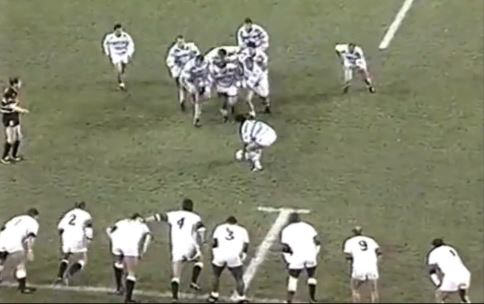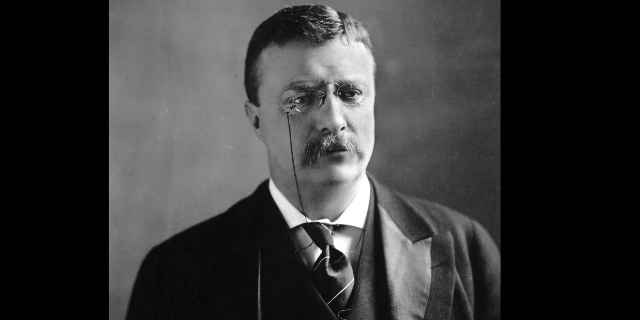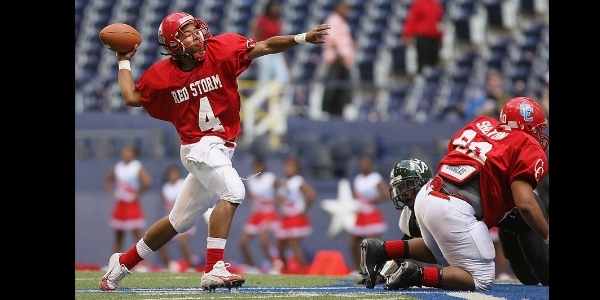In the early days, American Football was a violent and chaotic game that doesn’t bear much resemblance to the game we know now.
The single most infamous play from this era was the flying wedge. This article runs through the history of the play and why it was banned from the sport.
Violent Tactics In Early American Football
The sport was developing rapidly in the late 19th and early 20th centuries. Rules changed continuously in response to innovations by players and coaches.
Anything that would give an advantage was tried. It was common in the sport to punch or choke a player to make him drop the ball.
And coaches devised some crazily violent tactics for attacking play.
Here’s one of the craziest: coaches would put a player in a leather straight jacket with handles. His team would run down the field swinging him like a battering ram at the other team.
The battering ram was violent but not as effective as another play: the flying wedge.
The flying wedge went through three phases in its history. First, it became immensely popular with fans.
Then the rate of injuries and deaths became heavily scrutinized. The death rate drew the ire of reporters, college presidents, and a president of the United States.
Finally, it was banned! But what was the flying wedge exactly? Let’s take a closer look.
What Was The Flying Wedge In Football?
The flying wedge was the ultimate mass motion play in the early days of football. It looked like it sounds.
The heavier players on the team would form up into a tight wedge, holding onto each other. The ball carrier was in the center.
The entire wedge would aim itself at one player on the other team. The entire mass of the wedge would drive into him at a full run.
The players in the wedge didn’t just stand close to each other, they were tightly bound to each other. It was common for players to have leather handles on their uniforms to tighten their grip.
A televised example from rugby
I can’t show you any television clips from American Football because the move was banned in the early 20th century.
However, there’s another sport where the tactic crops up every now and then. The flying wedge is also banned in rugby. But that hasn’t stopped coaches from resurrecting the move from time to time.
Here’s a clip from an international match between Argentina and England in the 1995 Rugby World Cup. The footage is a little grainy, but the formation is clear.
And yes, the start of the play (from a penalty) very much resembles a football snap!

The Origins Of The Flying Wedge
In the 1890s football had become a very defensive game. Scoreless matches became more and more common. The entire match was often played between the twenty-yard lines.
The game had become completely stagnant.
When was the first flying wedge in football?
This all changed at a Harvard v. Yale match played in November of 1892. The game played out in front of more than twenty thousand spectators.
The first half of the match was the typical scoreless tie. When Harvard came out for the second half, they took the kickoff.
Ten men formed into a tight wedge with the eleventh in the middle holding the ball.
The entire three-quarters of a ton of momentum ran full tilt at Yale’s Alex Wallis. They flattened him and gained twenty yards past Wallis’s initial position. The Harvard fans went wild!
All football fans started talking about this play. The general belief was that it was the greatest invention in the history of the game.
Who invented the flying wedge?

This play was the creation of Harvard coach Lorin F. Deland. Deland had not only never played, he’d only seen his first game two years before.
He immediately became obsessed with the game. Deland was also fascinated by the military strategies of Napoleon. The coach set about creating plays based on Napoleon’s tactics.
One of Napoleon’s tactics was to mass a large number of his troops against a weak point in the enemy line. This allowed the attackers to break through into the enemy’s rear and scatter them.
The flying wedge was Deland’s recreation on a football field. And it was a tremendous success.
Early reaction to the new tactic
Parke Davis was a player, coach, and writer. He would later become a leader in criticizing the play.
However, this is what he wrote when he first saw it.
Sensation runs through the stands at the novel play, which is the most organized and beautiful one ever seen upon a football field.
Parke Davis
University of Chicago coach Amos Alonzo Stagg was so impressed that he perfected the play and soon it was being used from scrimmage as well as on kicks.
The excitement that the play added to the game is credited with a lot of the early growth in the popularity of football as a spectator sport.
Soon, everyone was running the wedge, and tactics were being devised to beat it. This usually involved countercharging wedges or players throwing themselves bodily at the wedge.
Death And The Fall Of The Flying Wedge

While the play was incredibly popular, a dark cloud soon began to develop. Quite simply, the play was too effective.
The massive amount of weight and momentum it brought to bear caused tremendous injuries, and even deaths.
Deland’s classic flying wedge was banned in 1894. But coaches are ingenious and the flying wedge was soon reconstituted and continued in slightly modified forms.
In 1905 alone, the flying wedge caused 22 deaths and 150 serious injuries.
The president of Harvard wanted to ban the game. Newspapers began to list the death and injury tolls every Monday. Editorials called for the end of the entire sport.
Theodore Roosevelt steps in

In response to the public outcry due to the carnage, United States President Theodore Roosevelt called a summit of all the most influential people in the game.
Roosevelt was a fan of the game and his son played at Harvard. The President wanted to save the game and reform its reputation.
All forms of the flying wedge were banned. The rules were changed to prevent any new variations of it.
The involvement of the President made the conclusions in this meeting definitive for the sport.
Impact On The Game Today
The impact of the flying wedge on modern football is tremendous, in a negative sense!
Many of the most common rules and characteristics of modern football are things that have been put in place to make it either
- impossible to form a wedge or
- impossible to get any type of mass momentum play going
Rules on formation behind the scrimmage
It’s not uncommon in a modern football game to see the teams line up and suddenly there is a sharp blast of a whistle. A penalty has been called because a lineman got into his stance a little too far back.
He has violated the rule about how many players must start on the line of scrimmage.
This rule exists to prevent teams from lining up in or forming wedges behind the line of scrimmage.
Rules preventing mass movement
Another example is when a penalty is called for too many players moving at once in the backfield. This may seem annoying and picky!
But this rule exists to prevent a scenario where players group and start a mass movement behind the line. Without the rule, they could charge and hit the line in a mass, just as the ball is snapped.
That’s a description of a flying wedge!
Introduction of the forward pass

The forward pass is probably the defining characteristic of modern football. However, it didn’t exist in the early development of the sport.
You can read more in our article on the early history of American football when it diverged from rugby.
The forward pass was largely allowed to replace the excitement caused by the flying wedge.
Walter Camp, one of the great founders of football, was bitterly opposed to the forward pass. However, even Camp admitted something had to replace the wedge as a generator of offense.
Last gasp of the flying wedge
There was a variant of the flying wedge that existed until very recently. This was on kicking plays.
When the receiving player caught the kick, three or four blockers would form up in front of him in a tight wedge. They would run down the field, clearing the way for the ball carrier.
The players were not allowed to hold each other. But the momentum they got because it was a kicking play was very similar to Deland’s original play.
The opposing team would send players after the wedge called wedge busters. It made kicks brutal and dangerous plays.
The NFL banned this tactic in 2009. This was the last vestige of the flying wedge in the sport.
Now, every blocker on a kicking play must be at least 2 feet from every other blocker.
Conclusion
The flying wedge had an enormous influence on the development of American football.
The play caused a surge of popularity for the sport when it was introduced by Harvard in 1892.
It has a significant influence on current modern formations.
Without the flying wedge, there would likely be no forward pass. American football, if it even existed, would look very different. It might look far more like a version of…rugby.
Check out our article on the flying wedge in the sport of Rugby Union.